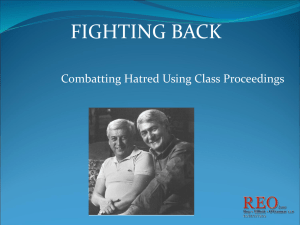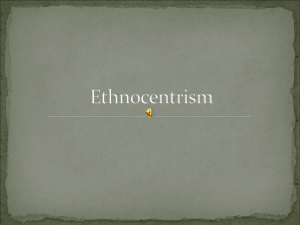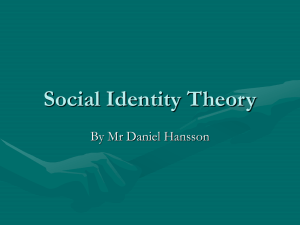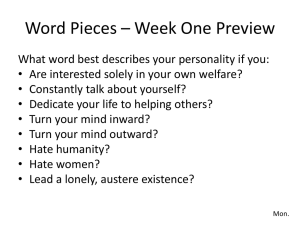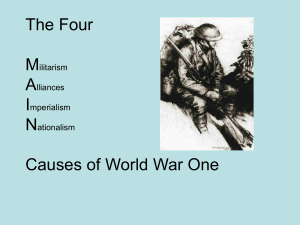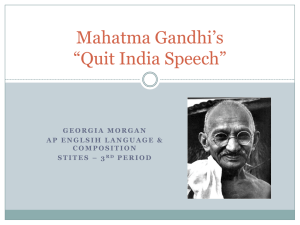here - Sites@Duke
advertisement
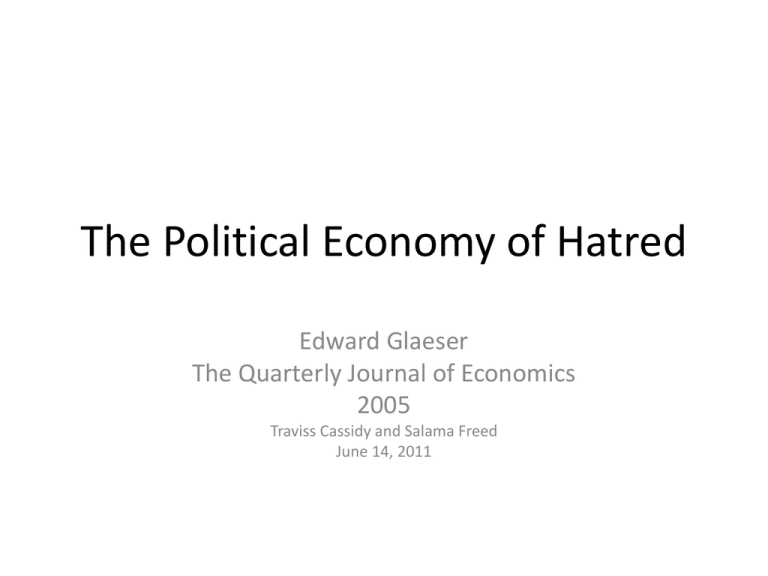
The Political Economy of Hatred Edward Glaeser The Quarterly Journal of Economics 2005 Traviss Cassidy and Salama Freed June 14, 2011 Outline of Discussion • • • • • • • Introduction Basic Tenets of Hatred The Hatred Model: Basic Sequence The Hatred Model: Expected Benefits The Hatred Model: Stage 2 The Hatred Model: Stages 1 and 3 Examples: – Racism in the American South United States – Anti-Semitism in 19th Century Europe – Islamic Hatred of Americans Basic Tenets of Hatred • “People say they hate because the object of their hatred is evil.”(Glaeser, 2005) • Hatred “stems from seeing oneself under attack” (Baumeister, 1995) • Hatred is often a characteristic of an entire group, not just those who are actually guilty of the crimes from which the hatred stems. • Glaeser argues in this paper that the spread of hatred is successful when voters have little incentive to investigate and dispute a false signal. The Hatred Model The Basic Sequence • Politicians spread hatred when their policies will harm a particular group in an effort to create desire to exclude or deprive the particular group. • There are four periods of the model: – Politician decide to spread hate filled message about particular group (“out-group”) to those not a member of that group (“in-group”). – In-group members receive signal, decide on a series of two actions • Whether the allegation deserves investigation, and • If credible, whether to protect themselves against out-group. – Members of both groups vote, and the winning politician gets their way – Out-group members may harm in-group members as a result of policies implemented The Hatred Model Expected Benefits • Three main constituents seek to maximize what is important to them: – Politicians maximize expected support minus the total cost of their campaign. – The in-group maximizes expected utility through all actions in the game where Utility= Net Income +Expected harm from out-group – investigation costs – self-protection costs – The out-group maximizes their net income. Note they are passive in the basic model (in that they are not receiving additional benefits) but are given an opportunity to become active in the future. The Hatred Model The Basic Sequence Stage 2 In-group receives signal of out-group danger Out-group is harmful with probability one or θ /(θ +φ(1-θ)) based on distribution Don’t Investigate Politician sends false signal to in-group of harmful nature of out-group Investigate In-group chooses to protect themselves Out-group is harmful Out-group is harmless Do nothing The Hatred Model Stage 2: The Response to Potential Harm • After receiving a signal, the in-group: – Decides whether to spend S to investigate the signal, then – Chooses whether to spend R to protect themselves from potential harm or reduce damages from said harm (by a factor of δ<1) • Note the benefit they will receive from protecting themselves outweighs the amount spent for in-group to protect themselves, so self-protection is optimal • Prop 1: Investigating and learning the truth of a story is only optimal iff the cost of the search is less than the gains from the investigation. – The cost of investigating the signal varies among the in-group, based on prior knowledge, frequent contact, or education, as well as other factors. • Less educated people will tend to dismiss false stories (and will likely have means to search for truth) • People who have frequent contact with the out-group will dismiss false stories as well. The Hatred Model Stage 2: The Response to Potential Harm • The expected costs of the in-group protecting themselves are based on their decision to investigate: – If they choose not to investigate , expected cost is cost of selfprotection plus reduced damage due to self protection (regardless of whether group is harmful). – If they choose to investigate: • If the story is false, expected cost from self-protection and damage is zero • If the story is true, expected cost is the cost of self-protection plus the reduced cost of damage after self-protection. • Total expected cost of protection is 𝜽 𝜹𝒅𝒚𝟎 + 𝐫 , 𝜽+𝝋 𝟏−𝜽 Where 𝒅𝒚𝟎 is the damage to the in-group’s net income, 𝜽 is the probability an outgroup is harmful, and 𝝋 is probability a politician will spread a false message. The Hatred Model Stage 2: The Response to Potential Harm • When the out-group is harmful, politicians do nothing because the message will be transmitted without their additional help and at no cost to them. – The portion of the in-group who has chosen to investigate believes that the outgroup is harmful with probability one. – The portion of the in-group who has not chosen to investigate believes that the out-group is harmful with probability 𝜃/(𝜃 + 𝜑 1 − 𝜃 ) • Note that the probability of success by politicians to spread negative messages adversely affects the in-group’s ability to discern a truly harmful group from a harmless one who has been negatively targeted. • If the out-group is harmless and the politician sends a false message: – A share who has chosen not to investigate believes the group is harmful with probability 𝜃/(𝜃 + 𝜑 1 − 𝜃 ). – The share who has chosen to investigate finds that the message is false and believes the group is harmful with probability zero. • We will focus on the spread of negative messages and hatred of a harmless group. The Hatred Model Stage 1: The Supply of Hatred • Politicians can spread hatred among in-group members at cost K. – K differs across politicians based on their abilities to effectively spread hate and the ability to distort the truth. – Voters do not know the value of K, but do know that K is drawn from a distribution. • Assuming two politicians with the fixed government policies of redistribution based on income: – Income of both the in-group and out-group is characterized by a continuous distribution 𝒇𝟎 𝒚 and 𝒇𝟏 (𝒚) – The mean income of the in-group minus mean income of the outgroup is ∆𝑦 = 𝑝∆𝑦 + (1 − 𝑝)∆𝑦, where p is the proportion of the population that belongs to the out-group The Hatred Model Stage 1: The Supply of Hatred • Our two candidates propose a tax level τ on their income – People whose income is below the average receives a transfer in the amount of 𝝉(𝒚 − 𝒚). – The two candidates propose two different tax levels, (𝝉𝑹 and 𝝉𝑨 , where 𝝉𝑹 > 𝝉𝑨 ) • The candidate who is against redistribution proposes tax level 𝝉𝑨 • The candidate who is in favor of redistribution proposes tax level 𝝉𝑹 – Those who support the anti-redistribution candidate: • Receive a financial gain of (𝝉𝑹 - 𝝉𝑨 ) 𝒚 − 𝒚 . • Effectively reduce the income of the out-group by a factor of (𝝉𝑹 - 𝝉𝑨 )(𝟏 − 𝒑)∆𝒚 – it is beneficial for those who hate the out-group to reduce that group’s resources. • Support the hatred spread against the poor out-group • Are generally the very rich. The Hatred Model Stage 1: The Supply of Hatred • The pro-redistribution candidate is supported : – By the out-group or those within the in-group who believe the outgroup is harmless only iff (𝝉𝑹 - 𝝉𝑨 ) 𝒚 − 𝒚 > 𝟎 – By haters only if the amount gained from redistribution less the cost of potential harm done by the out-group after redistribution is net positive. • Prop. 2: The pro-redistribution candidate benefits from hate iff ∆𝑦 < 0, i.e. if the mean income of the in-group is less than that of the out-group. • How do we choose to support a candidate? – The very poor will always support the pro-redistribution candidate. – The very rich will always support the anti-redistribution candidate. – The actions of the middle-income group members will vary , as they will choose to support the anti-distribution candidate when they hate the out-group. The Hatred Model Stage 1: The Supply of Hatred • Now assume Δ𝑦 >0 (in-group wealthier than out-group) – Only the anti-redistribution candidate spreads hatred • Prop. 3: There is a maximum cost K* that the anti-redistribution candidate is willing to incur to spread hatred – K* is rising with Δ𝑦 , 𝑑, 𝜃, and 𝛿, and falling with 𝑐𝐴 and 𝑝 – K* falls with the out-group’s proportion (λ) of the electorate – K* is rising with (the non-stochastic component of) s – Share of anti-redistribution candidates that spread hatred is falling with (the non-stochastic component of) K The Hatred Model Stage 1: The Supply of Hatred • φ = G(K*) in equilibrium – In-group voter’s subjective probability that the politician will send false signal is endogenous • Notice the opposing effects of increased information technology – Technology that lowers the cost of communication lowers s and K – Lower s means more people will choose to investigate the veracity of a story • Hatred-creating stories less effective – Lower K means it is easier for politicians to spread hatred-creating stories • Level of hatred increases The Hatred Model Stage 1: Antiminority Policies • Proposed poll taxes χ𝑅 , χ𝐴 on out-group members • Support for the anti-redistribution candidate will rise with the level of hatred iff s/he is less generous to out-group: – χ𝐴 + 𝜏𝑅 − 𝜏𝐴 1 − 𝑝 Δ𝑦 > χ𝑅 • Prop. 4: (Given that a mathematical condition [p. 63] holds) K* is rising with 𝝌𝑨 and falling with 𝝌𝑹 . • Anti-minority policies increase supply of hatred when proposed by antiredistribution candidate and decrease supply of hatred when proposed by pro-redistribution candidate. • What matters is whether anti-minority policies increase or reduce the differences in how candidates treat out-groups The Hatred Model Stage 1: H8ing the H8erz • Another way to fight hatred is to build hatred against the hate−creating politician. • If anti-redistribution candidate spreads hatred, at cost A + α the proredistribution candidate can spread hatred against the anti-redistribution candidate • Out-group members and in-group members who searched will believe antiredistribution candidate will impose costs of ω > 0. • Prop. 5: There is a value α* such that A + α* is the maximum amount the pro-redistribution candidate is willing to pay to villianize the antiredistribution candidate. • Given two mathematical conditions [p. 64], α* is falling and K* is rising with A and 𝑐𝑅 , and α* is rising with the proportion of voters who search The Hatred Model Noneconomic Issues, Multiple Issue Elections, and Exclusionary Policies • We can modify the model to include policies that have affect individuals through non−income channels. • 𝑥 : non-income variable • 𝜏(𝑥 − 𝑥): net tax payment • Support for the pro-redistribution candidate (p. 65) • The high tax candidate will support hatred if out-group is well endowed in 𝑥, and the low tax candidate will support hatred if out-group is poorly endowed in 𝑥. • All the previous results still apply Supporting Historical Examples • Racism in the United States • Anti-Semitism in 19th-Century Europe • Anti-Americanism in the Muslim world
